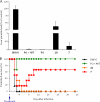Design and evaluation of primaquine-artemisinin hybrids as a multistage antimalarial strategy
- PMID: 21807973
- PMCID: PMC3186991
- DOI: 10.1128/AAC.05133-11
Design and evaluation of primaquine-artemisinin hybrids as a multistage antimalarial strategy
Abstract
It is widely accepted that the struggle against malaria depends on the development of new strategies to fight infection. The "magic bullet" thought to be necessary to reach eradication should not only provide treatment for all Plasmodium spp. that infect human red blood cells but should also eliminate the replicative and dormant liver forms of the parasite. Moreover, these goals should ideally be achieved by using different mechanisms of action so as to avoid the development of resistance. To that end, two hybrid molecules with covalently linked primaquine and artemisinin moieties were synthesized, and their effectiveness against the liver and blood stages of infection was compared in vitro and in vivo with those of the parent compounds. Both hybrids displayed enhanced in vitro activities, relative to those of the parent compounds, against Plasmodium berghei liver stages. Both compounds were about as potent as artemisinin against cultured Plasmodium falciparum (50% inhibitory concentration [IC(50)], ∼10 nM). When used to treat a murine P. berghei infection, one of the molecules displayed better efficacy than an equimolar mixture of the parent pharmacophores, leading to improved cure and survival rates. These results reveal a novel approach to the design and evaluation of antimalarials based on the covalent combination of molecules acting on different stages of the parasite life cycle.
Figures




Similar articles
-
Novel antimalarial chloroquine- and primaquine-quinoxaline 1,4-di-N-oxide hybrids: Design, synthesis, Plasmodium life cycle stage profile, and preliminary toxicity studies.Eur J Med Chem. 2018 Oct 5;158:68-81. doi: 10.1016/j.ejmech.2018.08.063. Epub 2018 Aug 30. Eur J Med Chem. 2018. PMID: 30199706
-
A primaquine-chloroquine hybrid with dual activity against Plasmodium liver and blood stages.Int J Med Microbiol. 2013 Dec;303(8):539-47. doi: 10.1016/j.ijmm.2013.07.005. Epub 2013 Aug 5. Int J Med Microbiol. 2013. PMID: 23992634
-
Curcumin-artemisinin combination therapy for malaria.Antimicrob Agents Chemother. 2006 May;50(5):1859-60. doi: 10.1128/AAC.50.5.1859-1860.2006. Antimicrob Agents Chemother. 2006. PMID: 16641461 Free PMC article.
-
The role of anti-malarial drugs in eliminating malaria.Malar J. 2008 Dec 11;7 Suppl 1(Suppl 1):S8. doi: 10.1186/1475-2875-7-S1-S8. Malar J. 2008. PMID: 19091042 Free PMC article. Review.
-
Considerations on the mechanism of action of artemisinin antimalarials: part 1--the 'carbon radical' and 'heme' hypotheses.Infect Disord Drug Targets. 2013 Aug;13(4):217-77. doi: 10.2174/1871526513666131129155708. Infect Disord Drug Targets. 2013. PMID: 24304352 Review.
Cited by
-
Ferrocenyl Quinoline-Benzimidazole Hybrids: A Multistage Strategy to Combat Drug-Resistant Malaria.Inorg Chem. 2025 Aug 11;64(31):16152-16167. doi: 10.1021/acs.inorgchem.5c02689. Epub 2025 Jul 31. Inorg Chem. 2025. PMID: 40742293 Free PMC article.
-
Quinoline-Based Hybrid Compounds with Antimalarial Activity.Molecules. 2017 Dec 19;22(12):2268. doi: 10.3390/molecules22122268. Molecules. 2017. PMID: 29257067 Free PMC article. Review.
-
A Hybrid of Amodiaquine and Primaquine Linked by Gold(I) Is a Multistage Antimalarial Agent Targeting Heme Detoxification and Thiol Redox Homeostasis.Pharmaceutics. 2022 Jun 12;14(6):1251. doi: 10.3390/pharmaceutics14061251. Pharmaceutics. 2022. PMID: 35745823 Free PMC article.
-
An Overview of Drug Resistance in Protozoal Diseases.Int J Mol Sci. 2019 Nov 15;20(22):5748. doi: 10.3390/ijms20225748. Int J Mol Sci. 2019. PMID: 31731801 Free PMC article. Review.
-
Antimalarial and antioxidant activities of novel artesunate-ellagic acid hybrid compound in vitro and in vivo.Front Pharmacol. 2024 Jun 18;15:1192659. doi: 10.3389/fphar.2024.1192659. eCollection 2024. Front Pharmacol. 2024. PMID: 38957387 Free PMC article.
References
-
- Aslanian R., et al. 2003. Identification of a dual histamine H1/H3 receptor ligand based on the H1 antagonist chlorpheniramine. Bioorg. Med. Chem. Lett. 13:1959–1961 - PubMed
-
- Baird J. K., Hoffman S. L. 2004. Primaquine therapy for malaria. Clin. Infect. Dis. 39:1336–1345 - PubMed
-
- Bell A. 2005. Antimalarial drug synergism and antagonism: mechanistic and clinical significance. FEMS Microbiol. Lett. 253:171–184 - PubMed
Publication types
MeSH terms
Substances
LinkOut - more resources
Full Text Sources
Medical
Miscellaneous

